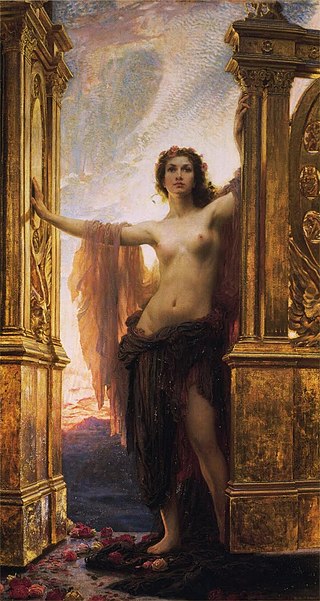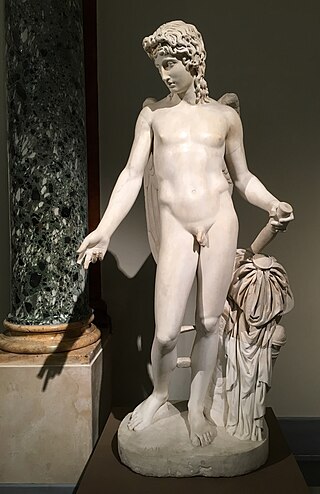
Aphrodite is an ancient Greek goddess associated with love, lust, beauty, pleasure, passion, procreation, and as her syncretized Roman goddess counterpart Venus, desire, sex, fertility, prosperity, and victory. Aphrodite's major symbols include seashells, myrtles, roses, doves, sparrows, and swans. The cult of Aphrodite was largely derived from that of the Phoenician goddess Astarte, a cognate of the East Semitic goddess Ishtar, whose cult was based on the Sumerian cult of Inanna. Aphrodite's main cult centers were Cythera, Cyprus, Corinth, and Athens. Her main festival was the Aphrodisia, which was celebrated annually in midsummer. In Laconia, Aphrodite was worshipped as a warrior goddess. She was also the patron goddess of prostitutes, an association which led early scholars to propose the concept of "sacred prostitution" in Greco-Roman culture, an idea which is now generally seen as erroneous.

In ancient Greek mythology and religion, Eos is the goddess and personification of the dawn, who rose each morning from her home at the edge of the river Oceanus to deliver light and disperse the night. In Greek tradition and poetry, she is characterized as a goddess with a great sexual appetite, who took numerous lovers for her own satisfaction and bore them several children. Like her Roman counterpart Aurora and Rigvedic Ushas, Eos continues the name of an earlier Indo-European dawn goddess, Hausos. Eos, or her earlier Proto-Indo-European (PIE) ancestor, also shares several elements with the love goddess Aphrodite, perhaps signifying Eos's influence on her or otherwise a common origin for the two goddesses. In surviving tradition, Aphrodite is the culprit behind Eos' numerous love affairs, having cursed the goddess with insatiable lust for mortal men.

A goddess is a female deity. In many known cultures, goddesses are often linked with literal or metaphorical pregnancy or imagined feminine roles associated with how women and girls are perceived or expected to behave. This includes themes of spinning, weaving, beauty, love, sexuality, motherhood, domesticity, creativity, and fertility. Many major goddesses are also associated with magic, war, strategy, hunting, farming, wisdom, fate, earth, sky, power, laws, justice, and more. Some themes, such as discord or disease, which are considered negative within their cultural contexts also are found associated with some goddesses. There are as many differently described and understood goddesses as there are male, shapeshifting, or neuter gods.

In ancient Greek religion and Greek mythology, Pasiphaë was a queen of Crete, and was often referred to as goddess of witchcraft and sorcery. The daughter of Helios and the Oceanid nymph Perse, Pasiphaë is notable as the mother of the Minotaur. She conceived the Minotaur after mating with the Cretan Bull while hidden within a hollow cow that the Athenian inventor Daedalus built for her, after Poseidon cursed her to fall in love with the bull, due to her husband, Minos, failing to sacrifice the bull to Poseidon as he had promised.

Venus is a Roman goddess, whose functions encompass love, beauty, desire, sex, fertility, prosperity, and victory. In Roman mythology, she was the ancestor of the Roman people through her son, Aeneas, who survived the fall of Troy and fled to Italy. Julius Caesar claimed her as his ancestor. Venus was central to many religious festivals, and was revered in Roman religion under numerous cult titles.

Sacred prostitution, temple prostitution, cult prostitution, and religious prostitution are purported rites consisting of paid intercourse performed in the context of religious worship, possibly as a form of fertility rite or divine marriage. Scholars prefer the terms "sacred sex" or "sacred sexual rites" in cases where payment for services is not involved.

In Greek mythology, Hermaphroditus was a child of Aphrodite and Hermes. According to Ovid, he was born a remarkably handsome boy whom the naiad Salmacis attempted to rape and prayed to be united with forever. A god, in answer to her prayer, merged their two forms into one and transformed him into a hermaphrodite, he being considered the origin of the name. His name is compounded of his parents' names, Hermes and Aphrodite. He was one of the Erotes.

Rati is the Hindu goddess of love, carnal desire, lust, passion, and sexual pleasure. Usually described as the daughter of Prajapati Daksha, Rati is the female counterpart, the chief consort and the assistant of Kama (Kamadeva), the god of love. A constant companion of Kama, she is often depicted with him in legend and temple sculpture. She also enjoys worship along with Kama.

In Greek mythology, Eros is the Greek god of love and sex. His Roman counterpart is Cupid ('desire'). In the earliest account, he is a primordial god, while in later accounts he is described as one of the children of Aphrodite and Ares and, with some of his siblings, was one of the Erotes, a group of winged love gods.

In classical mythology, Cupid is the god of desire, erotic love, attraction and affection. He is often portrayed as the son of the love goddess Venus and the god of war Mars. He is also known as Amor. His Greek counterpart is Eros. Although Eros is generally portrayed as a slender winged youth in Classical Greek art, during the Hellenistic period, he was increasingly portrayed as a chubby boy. During this time, his iconography acquired the bow and arrow that represent his source of power: a person, or even a deity, who is shot by Cupid's arrow is filled with uncontrollable desire. In myths, Cupid is a minor character who serves mostly to set the plot in motion. He is a main character only in the tale of Cupid and Psyche, when wounded by his own weapons, he experiences the ordeal of love. Although other extended stories are not told about him, his tradition is rich in poetic themes and visual scenarios, such as "Love conquers all" and the retaliatory punishment or torture of Cupid.

In Ancient Greek religion and mythology, the Erotes are a collective of winged gods associated with love and sexual intercourse. They are part of Aphrodite's retinue. Erotes is the plural of Eros, who as a singular deity has a more complex mythology.

Fertility was often mentioned in many mythological tales. In mythology, fertility deities exist in different belief systems or religions.
Sacred prostitution, also known as temple or cult prostitution, involved various activities in ancient times, many of which that occurred in Greece were in some way related to the Greek goddess Aphrodite and the Greek city of Corinth. The reason for the fascination with prostitution in general was because in ancient times, women’s bodies were viewed as more sexually desirable than men’s because of their potential fertility, and sexuality and fertility were celebrated for these aspects of them. In terms of their bodily functions and their purpose, women’s bodies were more valued than men’s because of their potential fertility, and therefore were viewed as more sexually desirable than men’s. This led to an interest in prostitution, and sacred prostitution was a form of prostitution in which people dedicated either themselves or their children to their deity as a form of religious worship.
















